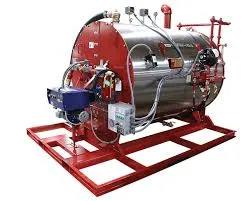
Nov . 28, 2024 04:30 Back to list
Steam Boiler System Overview and Component Interaction Explained
Understanding the Steam Boiler System Diagram
A steam boiler system is an essential component of many industrial and commercial applications, providing an efficient means of heating and generating steam for various uses. Understanding the intricate details of a steam boiler system diagram can significantly enhance one’s comprehension of its operation, components, and maintenance requirements.
Overview of the Steam Boiler System
At its core, a steam boiler works by using fuel to heat water, converting it into steam. This steam can then be utilized for heating purposes, powering turbines, or even in manufacturing processes. The efficiency and safety of a boiler system hinge on its design and the components involved, making it crucial to understand how each part interacts with one another.
Key Components in a Steam Boiler System
1. Boiler Shell The boiler shell is the main body of the boiler where water is heated to produce steam. Typically made from thick steel to withstand high pressure, the shell is designed to contain the water and steam safely.
2. Burner The burner is responsible for supplying fuel to the boiler. Different types of burners can be used depending on the type of fuel, including natural gas, oil, or coal. The burner ignites the fuel, creating the necessary heat for steam generation.
3. Heat Exchanger This component is essential for transferring heat from the burner to the water in the boiler. Efficient heat exchange is critical for maximizing the boiler's efficiency, thus reducing fuel consumption and emissions.
4. Steam Drum The steam drum is where steam collects and separates from water. It is an integral part of the boiler's design, ensuring that only the steam is sent to the various applications while maintaining water for reheating.
5. Water Feed System This system is responsible for supplying water to the boiler. It typically includes a water pump, feedwater heater, and control valves that regulate the flow and temperature of incoming water.
steam boiler system diagram

6. Safety Valves Safety valves are crucial for ensuring that pressure within the boiler does not exceed safe limits. When pressure exceeds a certain threshold, the safety valve opens to release steam, preventing potential explosions.
7. Control System Modern steam boiler systems utilize control systems that monitor and regulate temperature, pressure, and water levels within the boiler. Automated controls minimize human error and promote safe operation.
The Flow of Operation
Understanding the flow of operation within a steam boiler system is vital. The process begins with the water feed system, which fills the boiler with water. The burner ignites and generates heat, which is transferred through the heat exchanger to the water in the boiler shell. As the water heats up, it eventually transforms into steam, rising into the steam drum.
Once in the steam drum, the steam can be directed to various applications, such as heating a building or powering turbines for electricity generation. Throughout this process, the control system continuously monitors the pressure and temperature to ensure safe operation. If any anomalies are detected, the safety valves automatically engage to release excess pressure.
Importance of Regular Maintenance
A steam boiler system requires regular maintenance to ensure its efficiency and longevity. Routine inspections should include checking for leaks, testing safety valves, and assessing the condition of the burner and heat exchanger. Proper maintenance not only optimizes performance but also enhances safety and reduces the risk of catastrophic failures.
Conclusion
In summary, a steam boiler system diagram is more than a mere illustration; it is a comprehensive representation of the components and processes involved in steam generation. By grasping these concepts, operators and technicians can ensure optimal performance, safety, and reliability in their steam boiler systems. Whether for heating, power generation, or industrial processes, an efficient steam boiler remains a cornerstone of operational success in many sectors.
-
High-Efficiency Commercial Oil Fired Steam Boiler for Industry
NewsJul.30,2025
-
High-Efficiency Biomass Fired Thermal Oil Boiler Solutions
NewsJul.30,2025
-
High Efficiency Gas Fired Thermal Oil Boiler for Industrial Heating
NewsJul.29,2025
-
High-Efficiency Gas Fired Hot Water Boiler for Sale – Reliable & Affordable
NewsJul.29,2025
-
High Efficiency Biomass Fired Hot Water Boiler for Industrial and Commercial Use
NewsJul.29,2025
-
High-Efficiency Biomass Fired Hot Water Boiler for Industrial Use
NewsJul.28,2025
Related PRODUCTS






















